Every Gen 5 NVMe SSD On Show at Computex 2023
I think it would be fair to say that 2023 is fast turning into the REAL launch year for Gen 5 NVMes. Although the impact of factors such as the pandemic, hardware shortages and political tensions in trading blocks has delayed the planned rollout for PCIe Gen 5 M.2 SSDs from 2022 as it was anticipated, 2023 has seen a huge boost in the number of brands that have introduced their own Gen 5 SSDs (with 3-4 Gen5 controllers currently bubbling to the top from Phison, Innogrit and Silicon Motion) and Computex 2023 turned out to be the debut of several new SSDs (as well as the final physical reveal of some drives that upto this point had been little more than ‘press release’ fodder). There is still an argument to be made whether the average domestic client machine is going to be able to achieve significant jumps over Gen4 without the very latest gen CPU/Mobo combos, but still nonetheless, the Gen 5 SSD market has opened up significantly! So, today I want to go though all the PCIe Gen 5 SSDs that were at Computex 2023, what stood out about each of them and hopefully help you decide whether they deserve your data later in 2023.
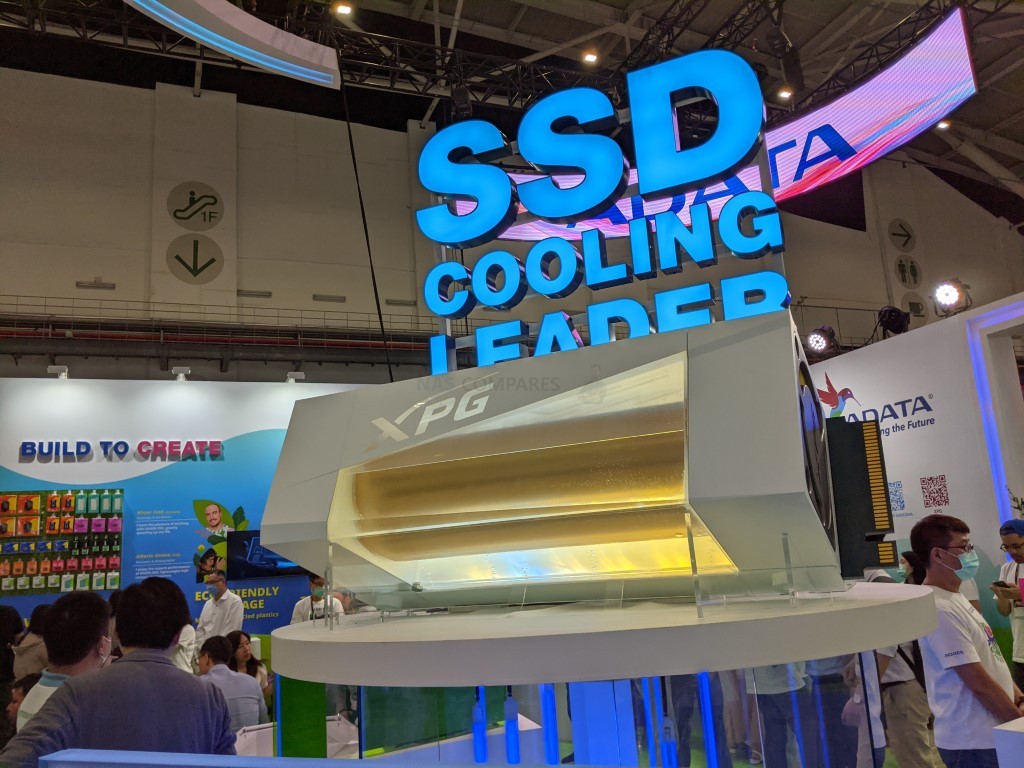
The ADATA Project Neonstorm Gen 5 SSD
Of all the Gen5 SSDs that were revealed at Computex, the ADATA Neonstorm made the BIGGEST SPLASH! With a large-scale model of the drive towering above their stand, it was very hard to miss! The ADATA Neonstorm is a unique drive for two specific reasons when compared to all the other drives revealed at Computex. With the first reason being that it is one of the very few water-cooled M.2 NVMe SSDs in the market (and the ONLY GEN5 SSD that arrives with a preattached, fan-assisted and water-cooled heatsink. It definitely it a very unique-looking SSD and much like other drives in the XPG series, arrives with an incredible sense of style.
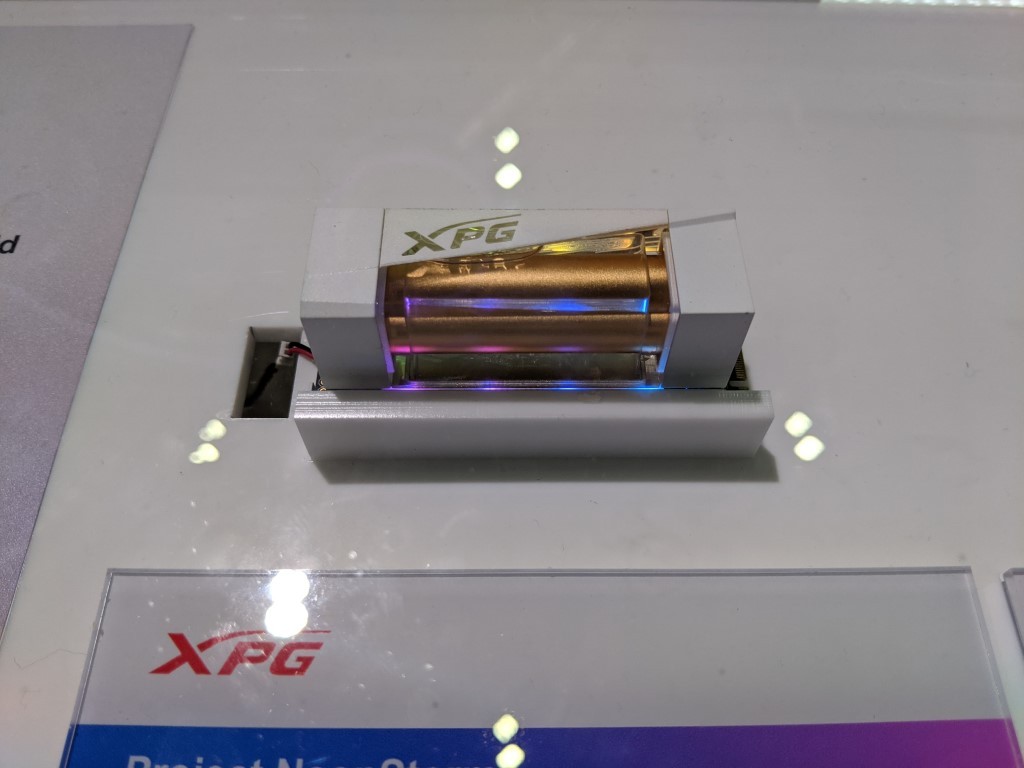
And 2) it is arriving with the Silicon Motion SM2508 controller! This is important, as 9/10 of Gen5 SSDs that have been revealed in the last 12 months are using the Phison E26 controller (as well as proprietary controllers as used by brands such as KOIXIA and Samsung). Currently, this controller, with the right NAND, has been reported to hit 14,000MB/s Sequential Read and 12,000MB/s Sequential Write – placing it higher than the Phison E26 controller’s current top speed. Additionally, this controller also reports a maximum IOPS of 2 Million 4K Random in both read and write – with ADATA maintaining that the Neonstorm can hit these numbers!
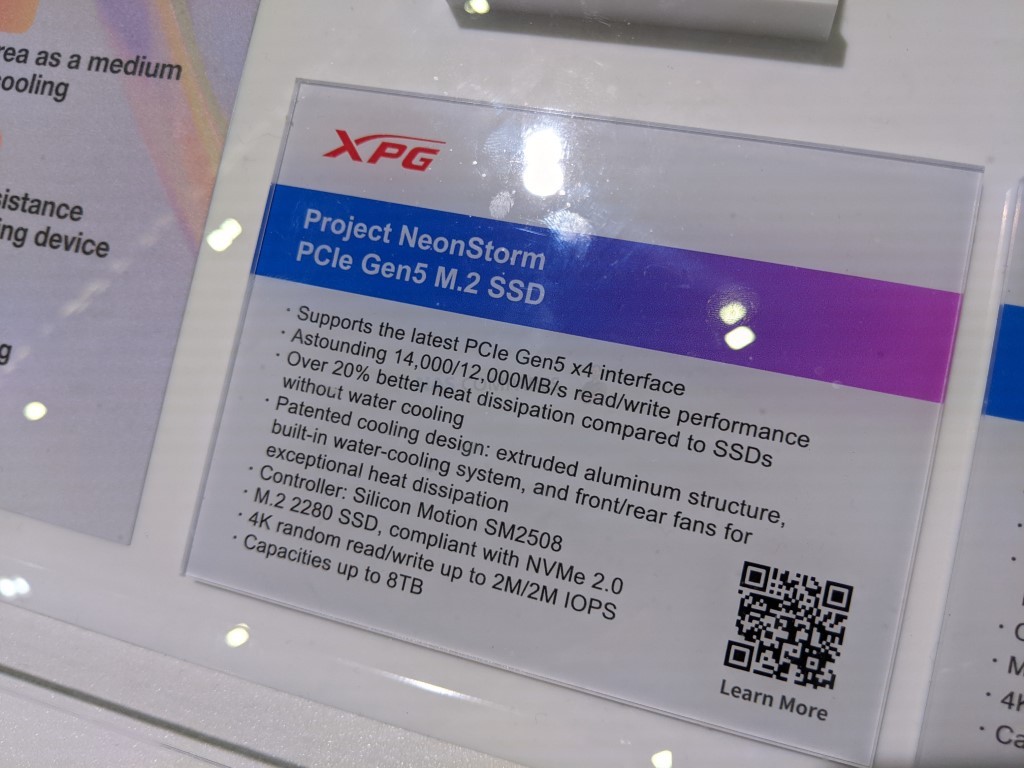
Like many of the SSDs that were shown at Computex, the ADATA project Neonstorm drive did not share much in the way of specifics about durability, but did report that the drive will be available in/after launch in upto 8TB – which is massive! Although there are a lot of SSDs that will be covered in this article, this is probably the most intriguing.
|
Brand |
ADATA XPG |
|
Model ID |
Project Neonstorm |
|
PCIe Gen |
PCIe Gen 5 x 4 |
|
Capacities |
Upto 8TB |
|
NAND |
3D TLC |
|
Controller |
Silicon Motion SM2508 |
|
Memory |
TBC |
|
Reported Max Transfer (Seq R/W) |
14GB/s / 12GB/s |
|
Reported Max IOPS (4K Random R/W) |
2 Million / 2 Million |
|
Durability |
TBC |
|
Includes Heatsink? |
Yes. Features Watercooling, Aluminimum Casing and top/bottom fans |
|
Notes |
The first drive to be revealed with the Silicon Motion SM2508 Controller and out performing currrently Phison E26 (which is currently peaking at 12GB/11GB) |
The ADATA Legend 970 Gen 5 SSD
Alongside The Project Neonstorm SSD, ADATA also took the opportunity at Computex 2023 to reveal another Gen 5 SSD in their lineup, the ADATA Legend 970. This drive was a little more conventional (if such a term can be used in this latest generation of NVMe SSDs), arriving with a far more traditional M.2 heatsink and performance numbers that are more comparable to a lot of the initially revealed Gen 5 SSDs back in 2022, when early prototypes started appearing.
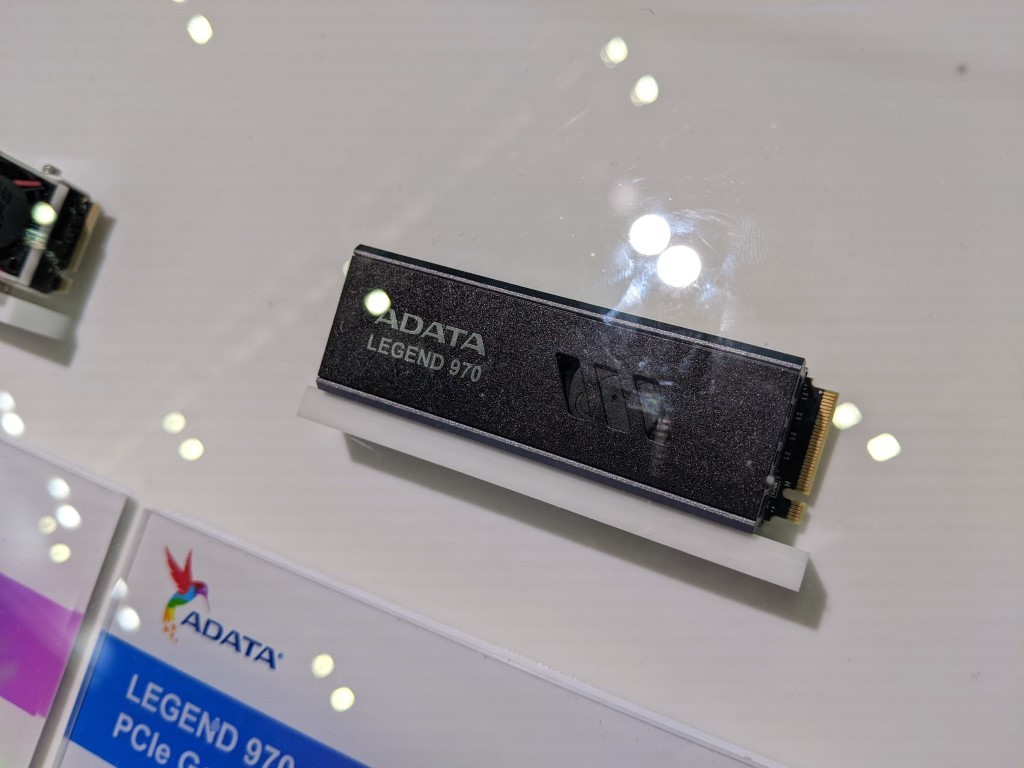
The reason for this arguably more mainstream performance from this Gen 5×4 SSD is because unlike the Neonstorm arriving with a rather unique controller, the ADATA Legend 970 arrives with the popular Phison E26 Gen5 controller that a vast number of other SSDs have been launched within this generation.
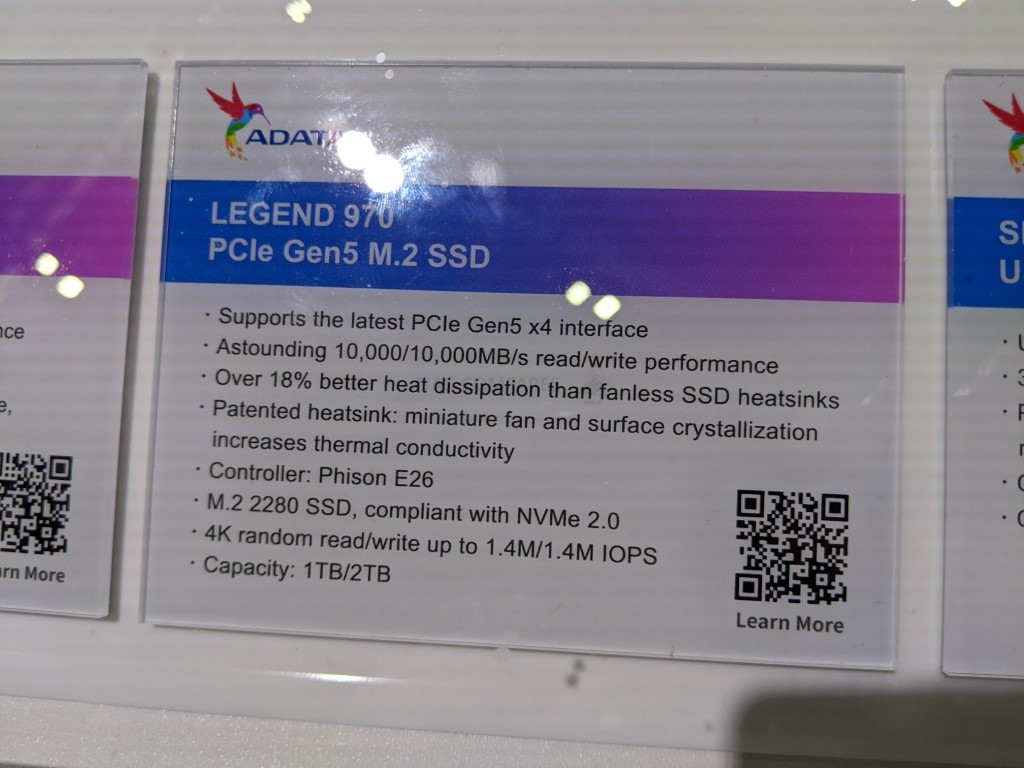
That doesn’t detract from it having solid performance numbers and definitely serves as a more affordable and realistic alternative to the still WiP Neonstorm.
|
Brand |
ADATA XPG |
|
Model ID |
Legend 970 |
|
PCIe Gen |
PCIe Gen 5 x 4 |
|
Capacities |
1-2TB |
|
NAND |
3D TLC NAND |
|
Controller |
Phison E26 |
|
Memory |
TBC |
|
Reported Max Transfer (Seq R/W) |
10GB / 10GB |
|
Reported Max IOPS (4K Random R/W) |
1.4 Million / 1.4 Million |
|
Durability |
TBC |
|
Includes Heatsink? |
Yes, Fanless, Compact surface area |
|
Notes |
The Patriot Viper PV553 Gen 5 SSD
Patriot was another brand that took the chance at Computex 2023 to reveal two SSDs, a prototype ‘in progress’ one and a ‘close to release’ featured drive – the Patriot Viper PV553 is the latter! Arriving with a proprietary heatsink, that although one of the most compact/low of any of the SSDs at the show, still has very good vent design and an onboard fan.
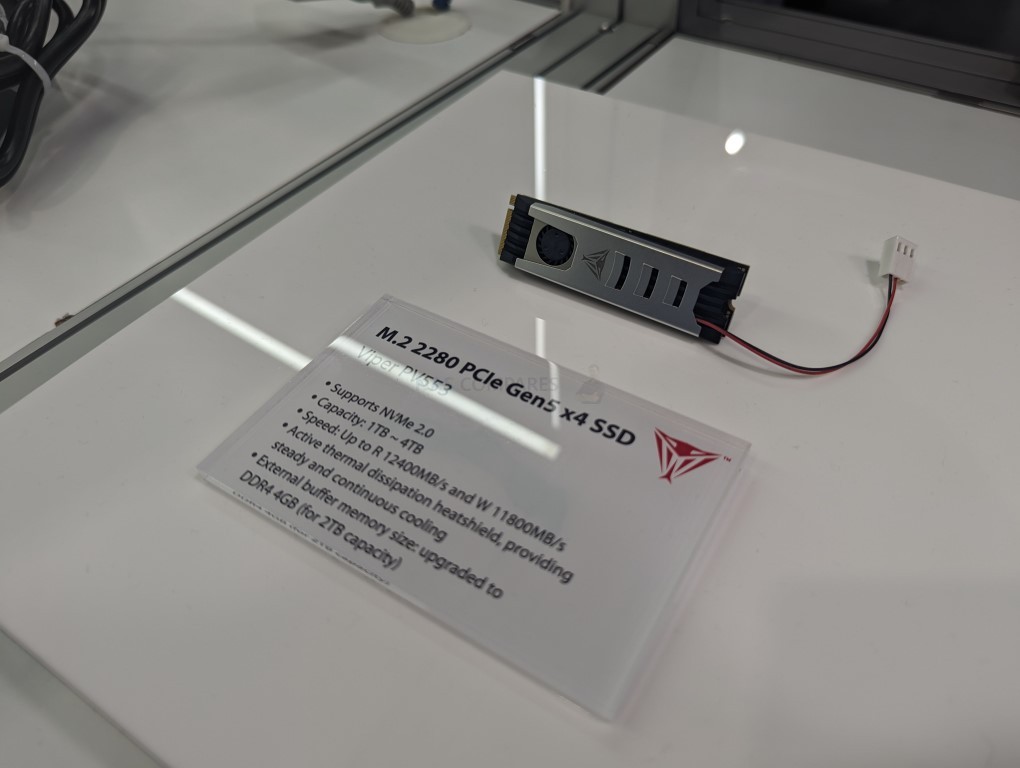
The hardware architecture is pretty familiar from what we saw, another Phison E26 Controller SSD, but they boasted performance numbers a pinch higher than others on a similar performance level. Now, they did not elaborate on how this was possible, but we can assume it arrives with 212 layer 3D TLC NAND (again, TBC), which would help things, as many of the initially revealed drives that keenly mentioned the use of this controller, were still yet to fully take advantage of the recent increases in layer density from brands like micron, etc.
The previous generation Patriot Viper VP4300 was a great drive and one we previously reviewed on the channel positively, also commenting on it’s affordability too. I can definitely see this new PV553 Gen5 drive following suit in order to gain a strong early foothold in this gen of NVMe SSDs.
|
Brand |
Patriot |
|
Model ID |
Viper PV553 |
|
PCIe Gen |
PCIe Gen 5 x 4 |
|
Capacities |
1TB, 2TB, 4TB |
|
NAND |
3D TLC NAND |
|
Controller |
Phison E26 |
|
Memory |
2-4GB DDR4 |
|
Reported Max Transfer (Seq R/W) |
12.4GB/s / 11.8GB/s |
|
Reported Max IOPS (4K Random R/W) |
TBC |
|
Durability |
TBC |
|
Includes Heatsink? |
Yes, heatsink, aluminium panel surround, connected fan |
|
Notes |
The Patriot DRAM-less Gen 5 SSD (In development)
Yep! As crazy as it sounds, with Gen 5 NVMes still barely being available globally and what there is being considered ‘first generation’, Patriot are waisting no time in stretching their muscles in this area by working on a DRAMless (I.e no on-drive memory) PCIe Gen 5×4 SSD. Now, if you are relatively new to SSDs (Gen 5 or otherwise) you might not quite understand the significance of this. I’ll get to that in a second, but despite this drive in development for Patriot arriving with DRAM , they state it can still hit 12,000MB/s Seq Read and 10,500MB/s Sequential Write. Which still puts in squarely in the ballpark of most other Gen 5 SSDs.
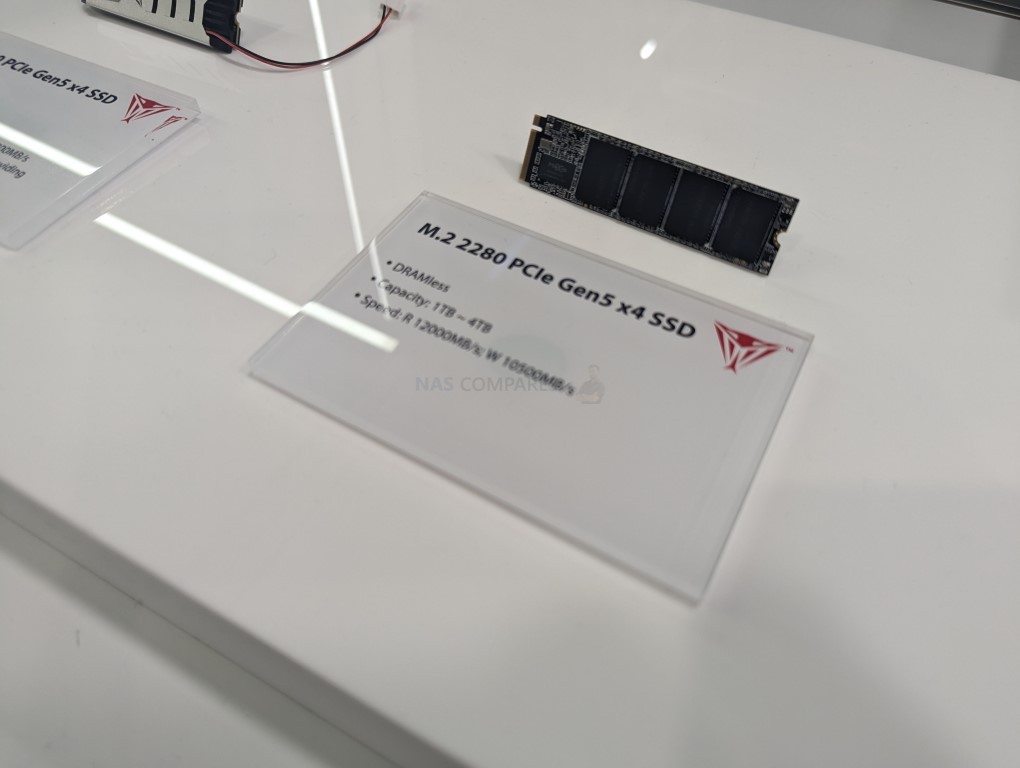
So, what does DRAMLESS mean? SSDs run not dissimilar to a computer. They need a CPU (the SSD Controller), storage space (the NAND, where your data lives) and in most cases, memory, to handle tasks on the fly. However, some SSDs that are designed for low sustained (I.e periods of time) tasks, low-powered systems and/or for a more affordable target market, will look at SSDs that make savings by running without the memory (I.e the DRAM). There are numerous Gen 3 and Gen 4 DRAMless SSDs – but these arrived later in the rollout of their respective generation of drive gens. Although Patriot did not flat out state which controller their DRAMless drive would arrive with, we can take an educated guess. Patriot has utilized Phison for their SSD controllers for a long time (particularly in the Gen4 generation) and recently Phison revealed their Gen5 DRAMLESS controller, the PS5031-E31T, supporting upto 8TB capacities, as well as both TLC and QLCC NAND. It’s tilll not 100% confirmed that this will be the controller it will be using, but it’s the most likely estimation at the time of writing.
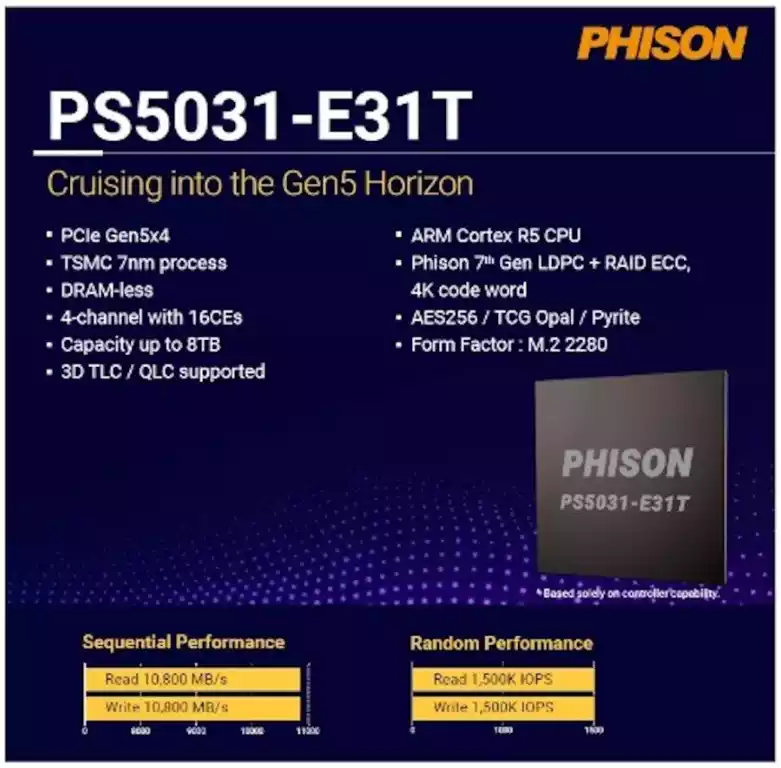
So, how can a DRAMless SSD match (and, according to Patriot, actually surpass other Gen5 SSDs) an SSD that has DRAM? Well, currently the infrastructure of systems that have rolled out with PCIe Gen 5 support are not really able to fully take advantage of to full performance benefits of PCIe Gen 5. This will change over time, but right now this is something of a system bottleneck across most devices outside of the exceptionally high end system arena. This will change of course, but it means that DRAMless SSDs might actually stand half a chance to compete. They just need to be viewed in the context of drives that cannot compete with DRAM drives in sustained operations! Also, if you thought the heatsinks on many Gen5 SSDs up to this point were big – imagine what this DRAMless Gen5 SSD is going to need! The prototype on show was just chips on a board, so there was no indication of how heat dissipation will eventually be realised, but it will be very interesting to find out!
|
Brand |
Pariot |
|
Model ID |
ProtoType |
|
PCIe Gen |
PCIe Gen 5 x 4 |
|
Capacities |
1TB, 2TB, 4TB |
|
NAND |
3D TLC NAND |
|
Controller |
Phison PS5031-E31T |
|
Memory |
No, DRAMLESS |
|
Reported Max Transfer (Seq R/W) |
12GB/s / 10.5GB/s |
|
Reported Max IOPS (4K Random R/W) |
1.5Million / 1.5 Million (Based on Phison Spec) |
|
Durability |
TBC |
|
Includes Heatsink? |
TBC |
|
Notes |
Still Work In Progress, |
Teamgroup T-Force Cardea Z5 Gen 5 SSD
Teamgroup were another brand that made quite a lot of noise at Computex 2023, with their new Cardea Z5 series front and center. Their Gen5 SSD was another Phison E26 SSD and one that boasted a 14GB/s Seq read – pretty much the consistent top end of what SSDs with their controller have been able to report max. That said, we know that the host system is going to need to be pretty top end to hit these kind of numbers.
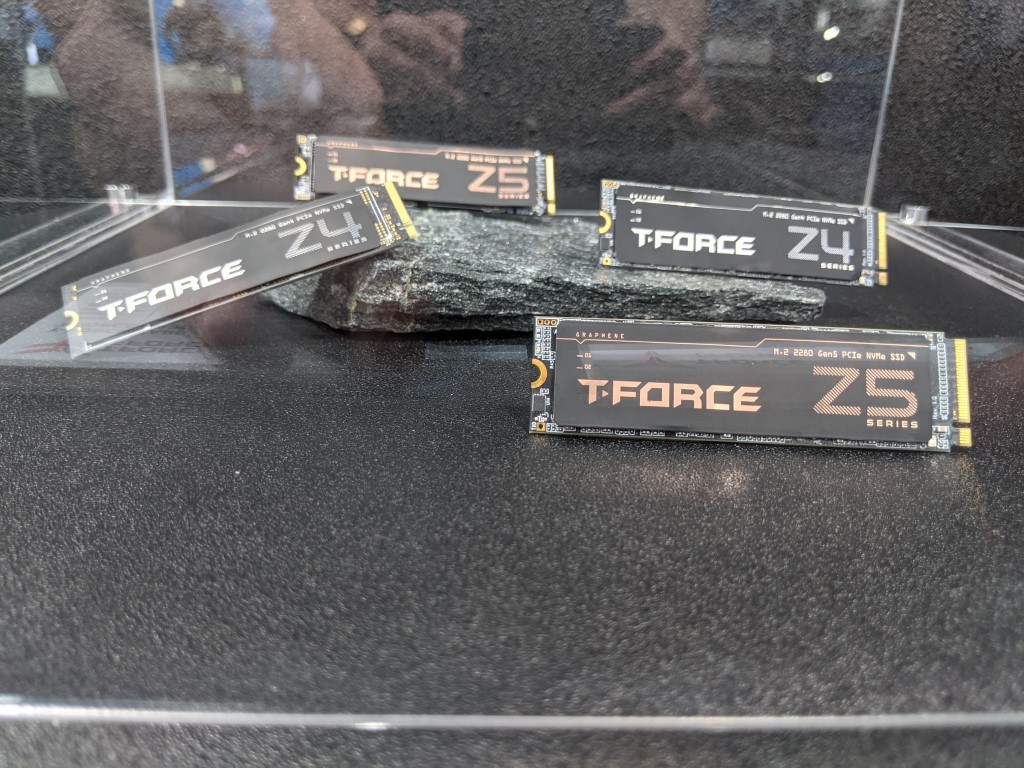
Alongside the reveal of the Teamgroup Cardea Z5 Gen5 SSD, they also showed off one of the BEST selections of Gen5 ready heatsinks of ANY brand at the show! The Teamgroup Dark Airflow Series (1, 2 and 3).
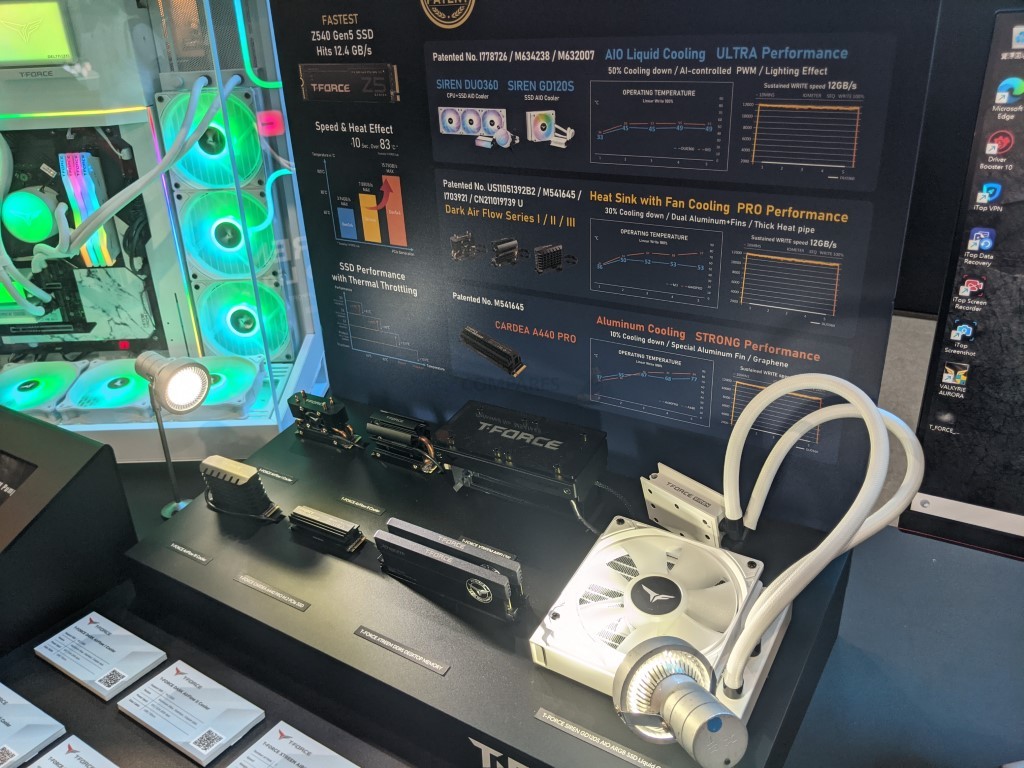
Starting with a chunky slated aluminium stack style heatsink that was finned from top to bottom, you then had a rotating structured heatsink with copper pipe design to pull air over the heatsink in a targetted fashion. Then you had the multi-layer plated heatsink (also with a copper pipe) that had an integrated fan.
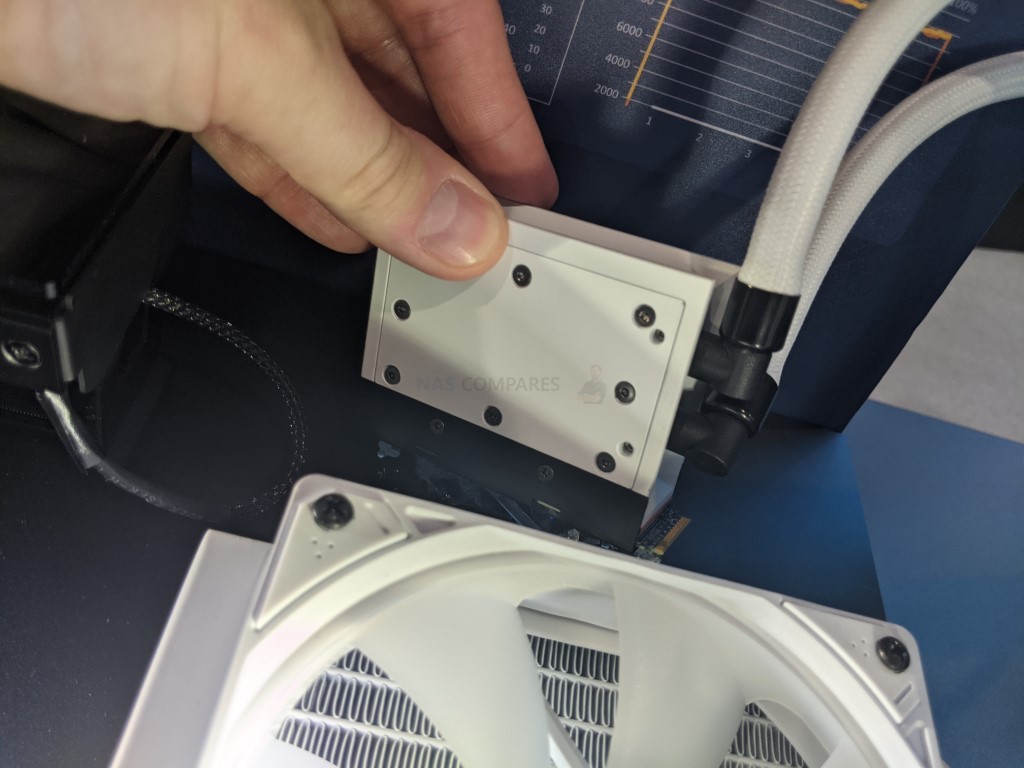
Finally, they had the water-cooling kit heatsink that arrived with it’s own dedicated and integrated system case fan and dual pipe water connections. Although the subject of SSD heat and potential throttling has been approached by many brands, this is by FAR the most impressive and detailed addressing of the subject by a brand. Both at Computex AND just generally in the whole Gen5 SSD scene right now. Kudos to them!
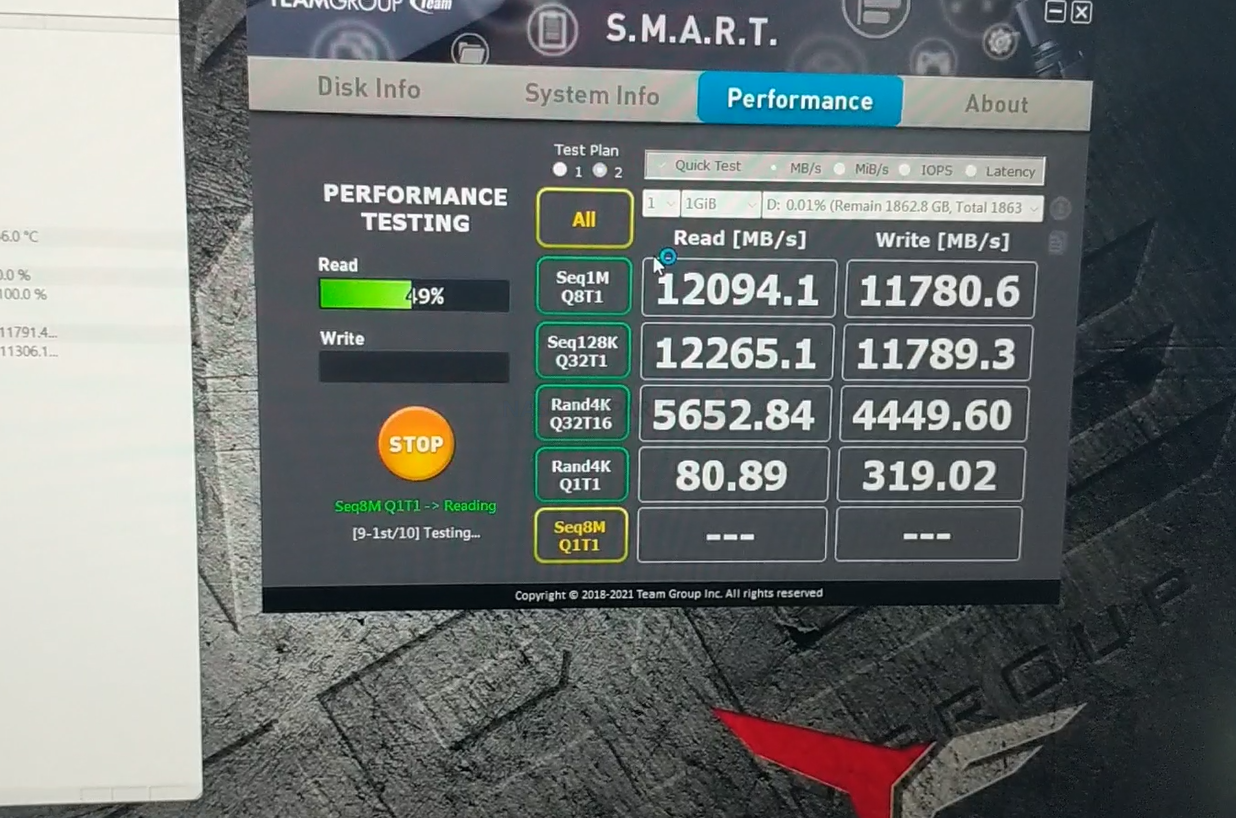
|
Brand |
Teamgroup |
|
Model ID |
Cardea Z5 |
|
PCIe Gen |
PCIe Gen 5 x 4 |
|
Capacities |
1TB – 2TB – 4TB |
|
NAND |
3D TLC NAND |
|
Controller |
Phison E26 |
|
Memory |
DDR4 |
|
Reported Max Transfer (Seq R/W) |
14GB/s / 11GB/s |
|
Reported Max IOPS (4K Random R/W) |
TBC |
|
Durability |
TBC |
|
Includes Heatsink? |
No (Has Heatshield) – Multiple Versions Available Optionally. The Dark Air Flow Series of H/S’ + the Siren GD120S Water Cooled Heatsink kit |
|
Notes |
Watercooloing Heatsink Option and many other versions |
The Gigabyte Aorus 12000 Gen5 SSD
When the very first wave of commercial/consumer Gen5 SSDs dropped, one of the first was the Gigabyte Aorus 10000 (which you can now buy), however the price of being ‘first’ to a new industry standard can all too often mean that your product loses out on the time when other brands wait a little longer and capitalize on growing efficiency and proficiency in the storage medium. That is clearly why Gigabyte then followed up that SSD with the reveal at Computex of the finished Gigabyte 12000 Gen5 SSD.
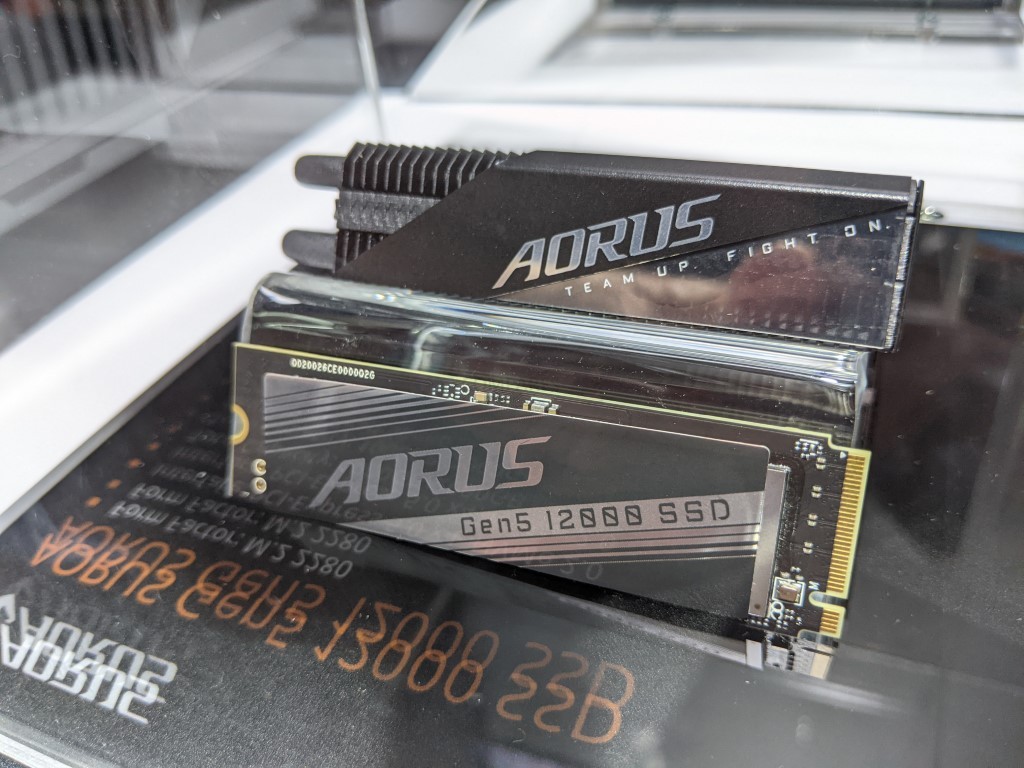
Now, the Gigabyte 12000 get’s its name from the reported 12GB/s seq Read (12,400MB/s Reported Max) and close to 12GB/s seq Write (Actually 11,800MB/s) that it can hit in an optimal system setup (a decent chunk better than the 10GB/10GB of the Gigabyte 10000) #.
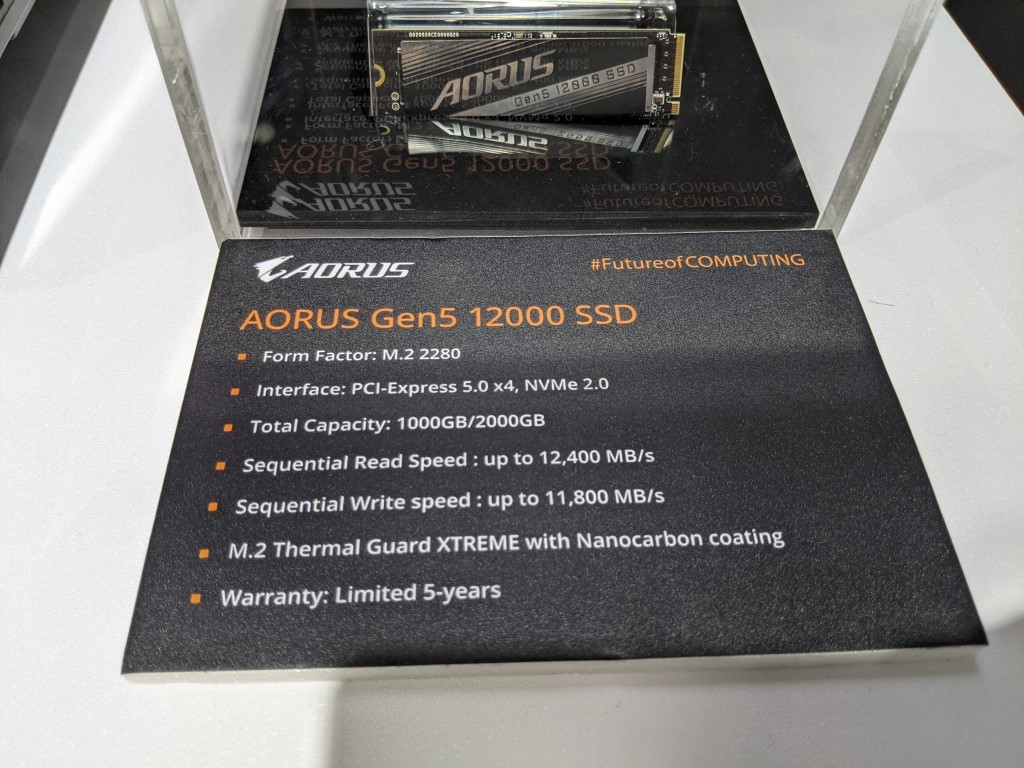
It’s another Phison E26 (shocker!) controller built SSD and although it is pretty comparable to the previous Gen5 release from them, it almost certainly benefits from improved NAND layer and perhaps a memory increase at the higher cap (TBC – but seeing a lot of that in the newest Gen5 E26 drives).
|
Brand |
Gigabyte |
|
Model ID |
Aorus 12000 |
|
PCIe Gen |
PCIe Gen 5 x 4 |
|
Capacities |
1TB – 2TB |
|
NAND |
3D TLC NAND |
|
Controller |
Phison E26 |
|
Memory |
DDR4 |
|
Reported Max Transfer (Seq R/W) |
12.4GB/s / 11.8GB/s |
|
Reported Max IOPS (4K Random R/W) |
TBC |
|
Durability |
TBC |
|
Includes Heatsink? |
Yes, Heat Pipe Version +vents + Nanocarbon Coating |
|
Notes |
Gigabyte Aorus 10000 Already Available |
The KIOXIA CM7 E3.1 Enterprise Gen5 SSD Series
And now for something completely different! Kioxia is arguably one of the most well-known brand in enterprise-grade SSD and with the data center class drives starting to roll out in small quantities, it was inevitable that KIOXIA would be one of the first and the loudest. We actually knew about the CM7 series prior to Computex 2023, but this was the drive’s first real public display. Arriving in two version, the CM7 series is designed for high performance, but also sustained and durable long-term reliability. First, we have the KIOXIA CM7SAS drive.
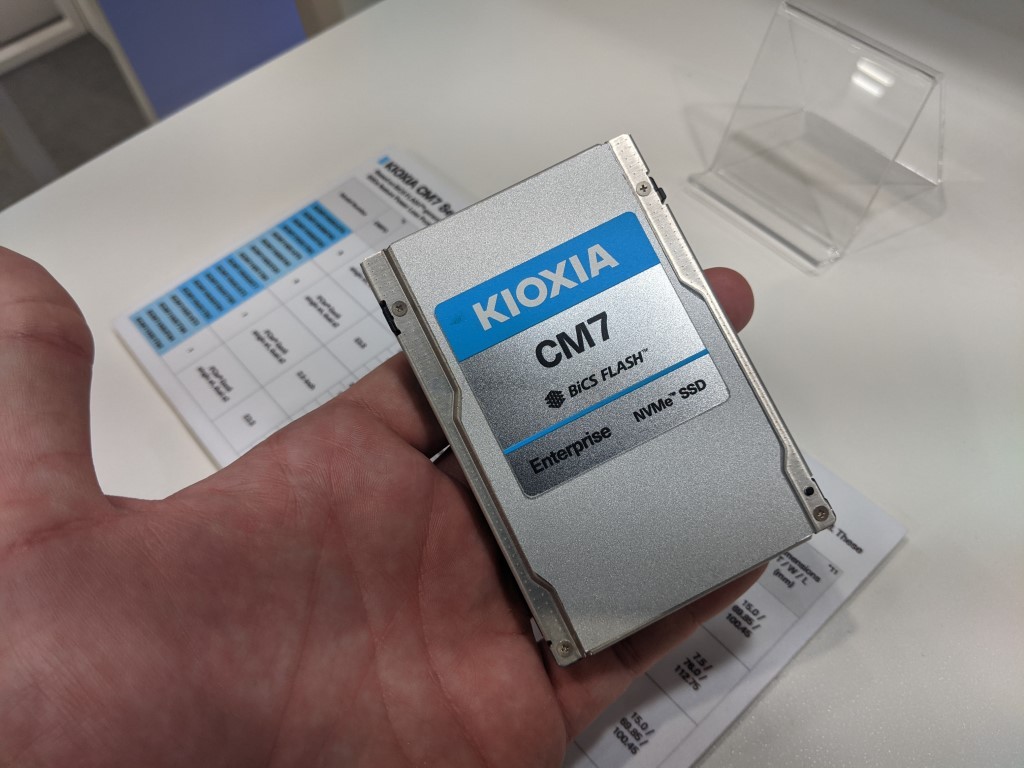
Arriving in a compact 7mm 2.5” casing, this drive directly outputs into SAS / U.3 connectivity (PCIe Gen5 Single x4, dual x2), as well as in capacities that start at 1980GB and then scale up massively to a whopping 30,720GB – whilst still maintaining that slim 7mm height! As these are data center class, needless to say, durability is HIGH! Starting at 1.0 DWPD (Drive Writes per Day) and ending at 3.0 DWPD. That means that, even keeping in mind the increase rigours of Gen5 writing, these drives can write 1-3 drives of fresh data a DAY (overwriting each time). They also peak at 14GB/s Seq Read (though their Seq Write peaks at 7GB/s)
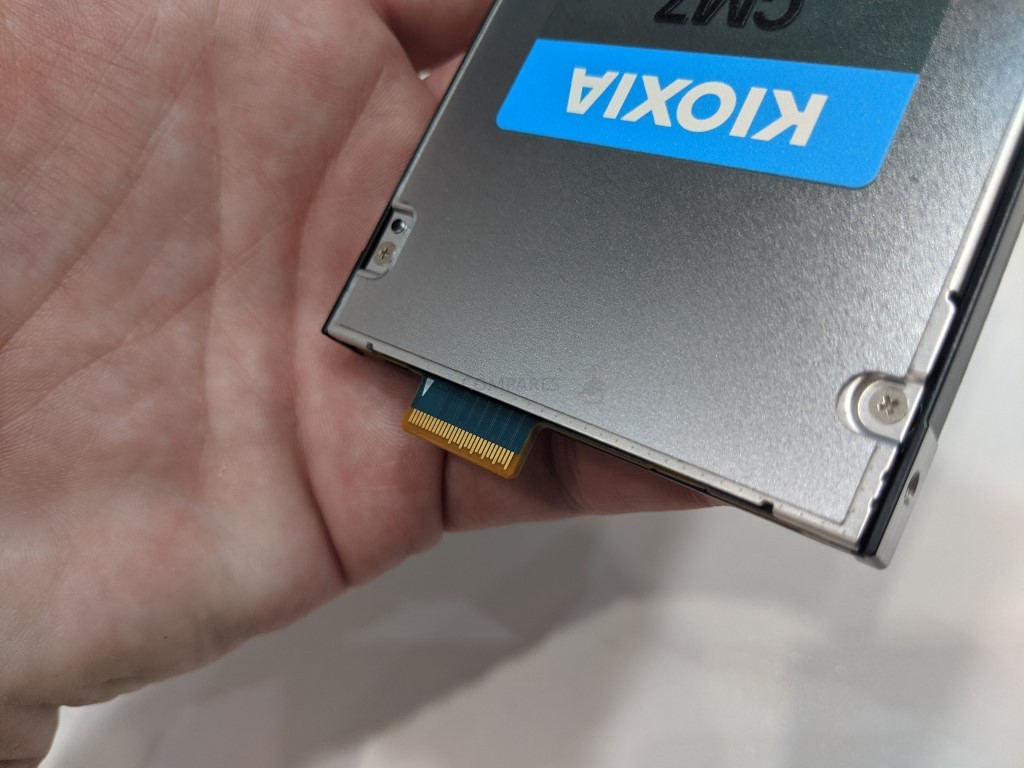
The other version of the KIOXIA CM7 Series on show was the E3,S version. E3.S is a part of the continuing evolution of PCIe storage to make it more data center/server efficient and convenient (better surface area for storage, chip distribution, hot swapping, etc) and it is no surprise that KIOXIA have entered this area so quickly (as have a few other enterprise SSD brands, sensing the way the wind is blowing!). It’s also worth mentioning that, as it is a data center class SSD, they both arrive with options for SED/Self-Encrypted-Drive, Power Loss Protection (PLP) and FIPS support.
|
Brand |
KIOXIA |
|
Model ID |
CM7 Series – E3.S Interface |
|
PCIe Gen |
PCIe Gen 5 x 4 |
|
Capacities |
1920GB – 30,720GB |
|
NAND |
112 Layer Proprietary 3D TLC NAND |
|
Controller |
Proprietary |
|
Memory |
DDR4 |
|
Reported Max Transfer (Seq R/W) |
14GB/s / 7GB/s |
|
Reported Max IOPS (4K Random R/W) |
TBC |
|
Durability |
1-3DWPD |
|
Includes Heatsink? |
In 2.5” 15MM-7MM Casing, SAS |
|
Notes |
Enterprise Grade, Durability Priority, Encryption Support, PLP, U.3 Support (downgrades to PCIe Gen4) |
The Samsung PM1743 U3.2 Gen5 SSD
Another SSD that we have discussed on the channel previously appeared, almost stealthily, at the Supermicro stand at Computex – The Samsung PM1743 SSD. This is an SSD that has popped up incredibly rarely since it was first revealed, with most devices already rolled out towards existing top tier hyperscale/unified storage users in early rollout in the background. Much like the KIOXIA CM7 series, the PM1743 is another U3.S SSD that is aimed at the EXACT same enterprise market.
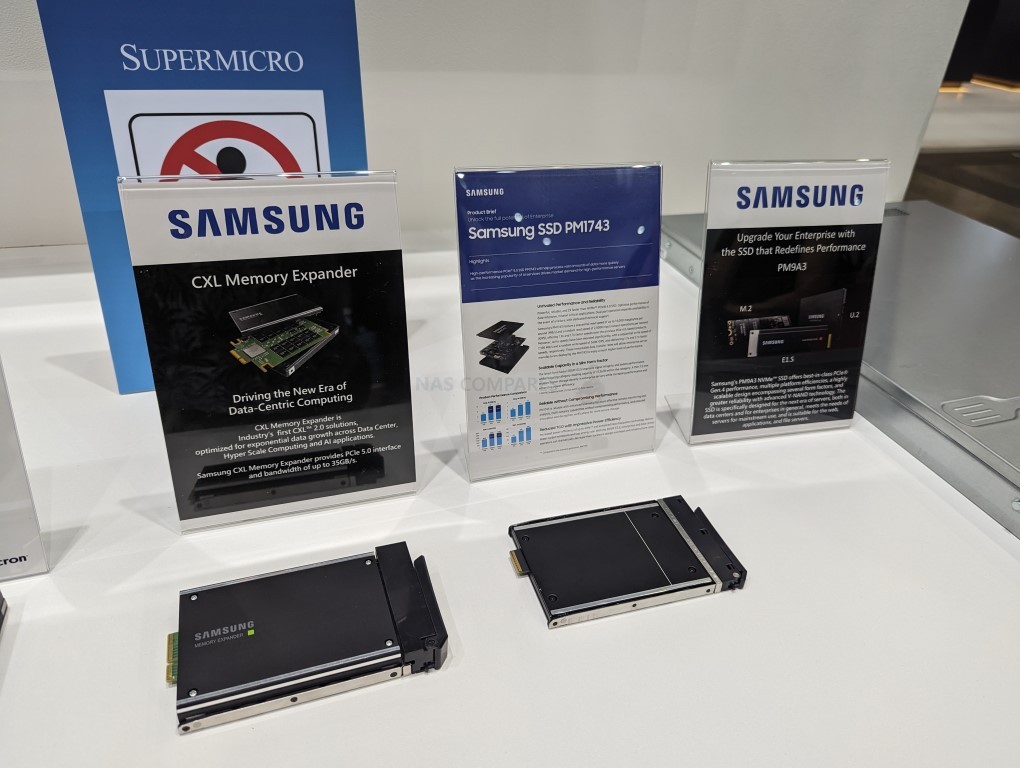
Samsung has been starting to turn things around following their slight struggles with NAND/Memory shortages (much like everyone else) but with the advantage (in most areas) or developing their SSD components ‘in-house’. This also means that the specifications of their components are a great deal harder to pin down, as they are most proprietary and more often than not, publicly withheld (same applies to the bulk of their SSD components in older-gen drives).
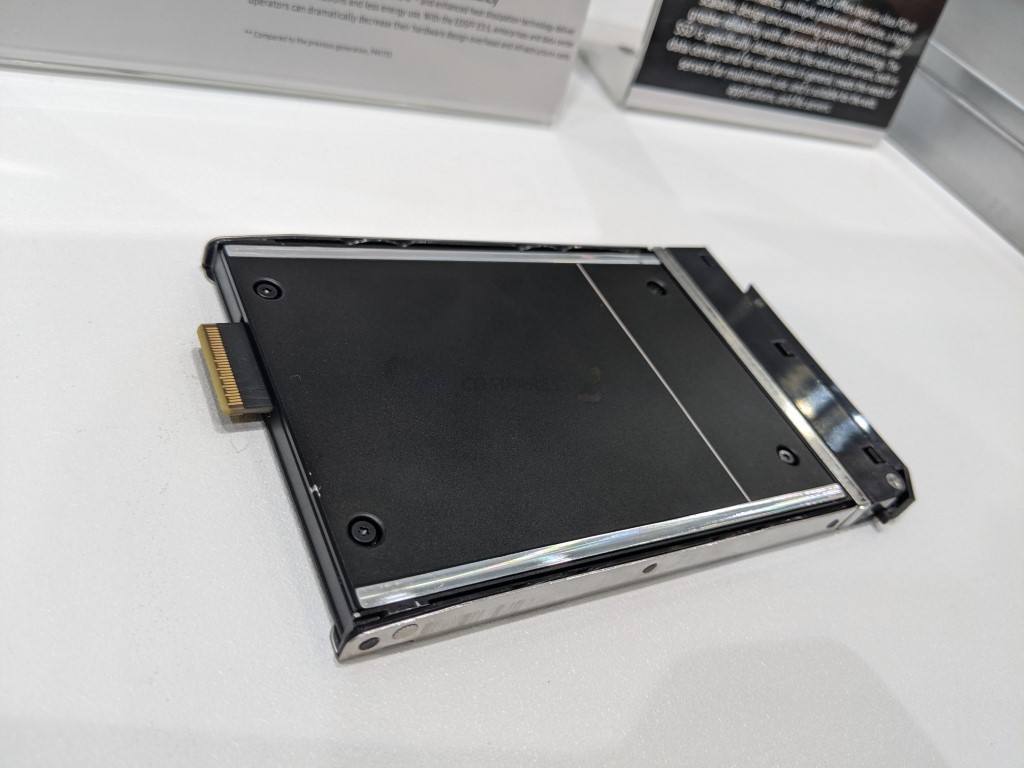
Samsung (along with Seagate and WD) are still among the BIGGEST names in SSD that have yet to reveal a consumer/M.2 NVMe SSD for Gen5, seemingly all prioritizing the data center class initially (where the money is!). But we will almost certainly see this change in the 2nd half of 2023. They also showed off the highly praised Samsung Gen 5 SSD Expander module.
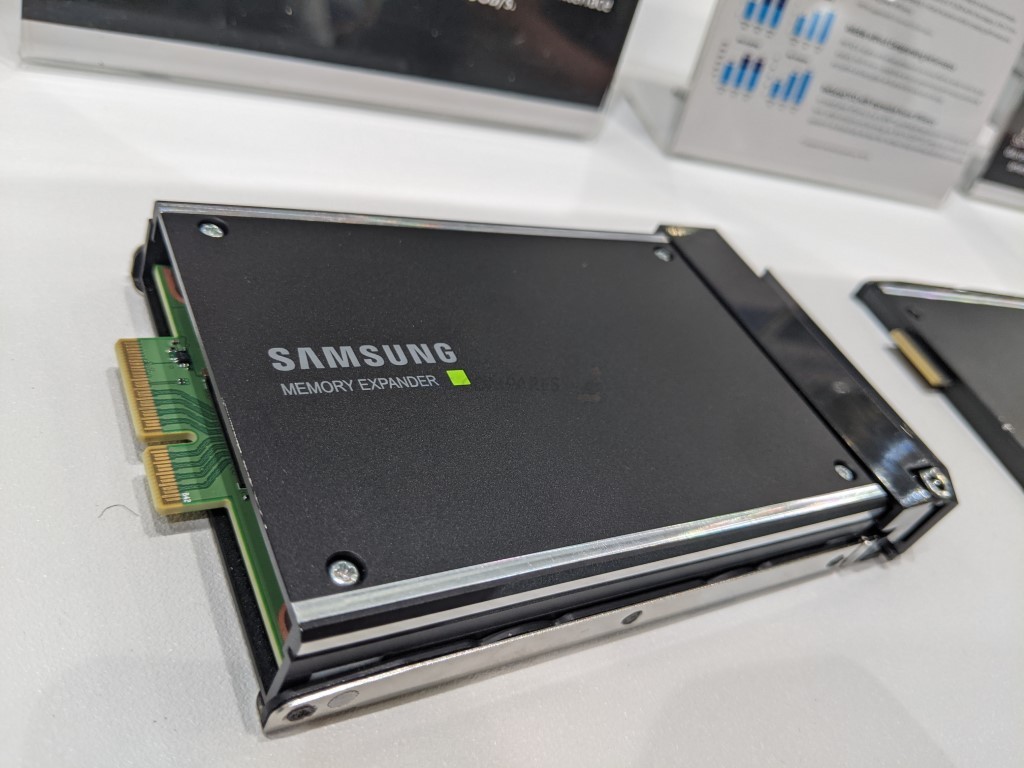
|
Brand |
Samsung |
|
Model ID |
PM1743 U3.S |
|
PCIe Gen |
PCIe Gen 5 x 4 |
|
Capacities |
1TB – 15.36TB |
|
NAND |
Proprietary |
|
Controller |
Proprietary |
|
Memory |
DDR4 |
|
Reported Max Transfer (Seq R/W) |
14GB/S / 7.1GB/s |
|
Reported Max IOPS (4K Random R/W) |
2.5 Million / 360K |
|
Durability |
TBC |
|
Includes Heatsink? |
Cased |
|
Notes |
U3.S Interface, 7mm Height, the CXL Memory Expander also on show at SuperMicro Stand |
The KLEVV CRAS C950 Gen5 SSD
A relatively lesser-known brand outside of Taiwan, KLEVV revealed their own Gen 5 SSD, the CRAS C950. Now, I include it here, despite it’s localized/limited global availability later, because it was a great example at Computex of Gen 5 SSD architecture and components starting to trick down into the lesser established brands. This is something we did not really see in the Gen4 generation for almost a year and a half.
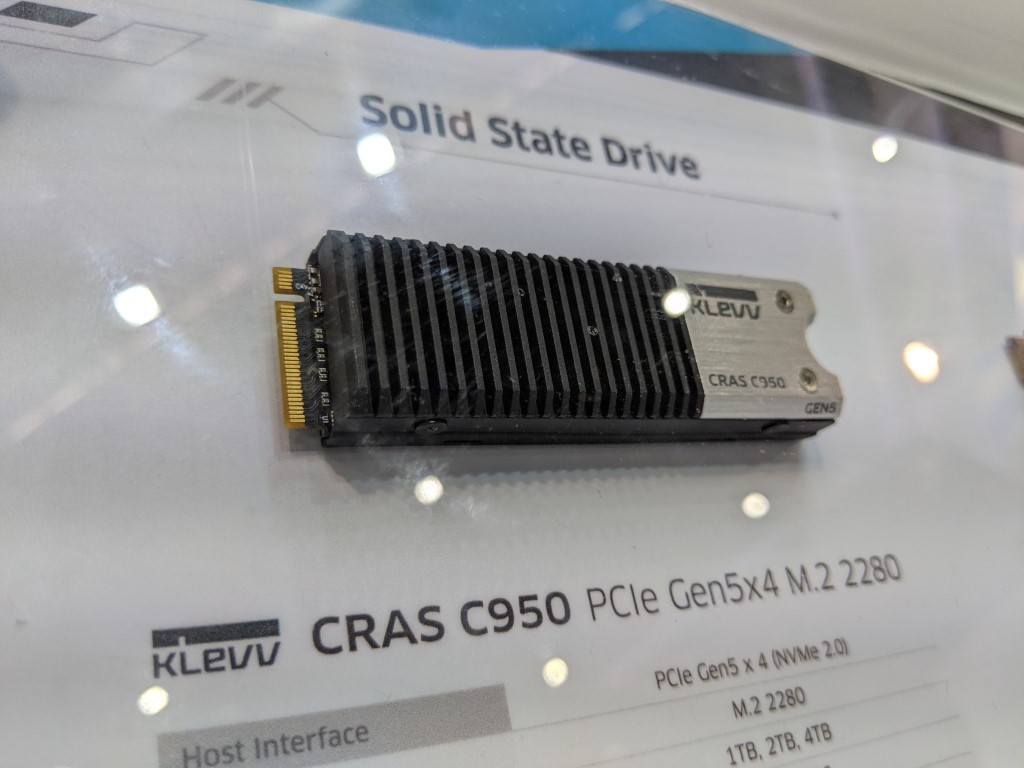
Yet, Gen5 has barely established itself and we have already started seeing the less prominent SSD brand begin to roll out their very own Phison E26 Gen5 SSDs. Arriving with a fairly standard heatsink that features a branded aluminium trim, the C950 is largely comparable to many of the standard Gen5 SSDs that have been revealed. Despite this though, it boasts availability in upto 4TB and transfer speeds of 12GB/s and 11GB/s Seq Read/Write, respectively.
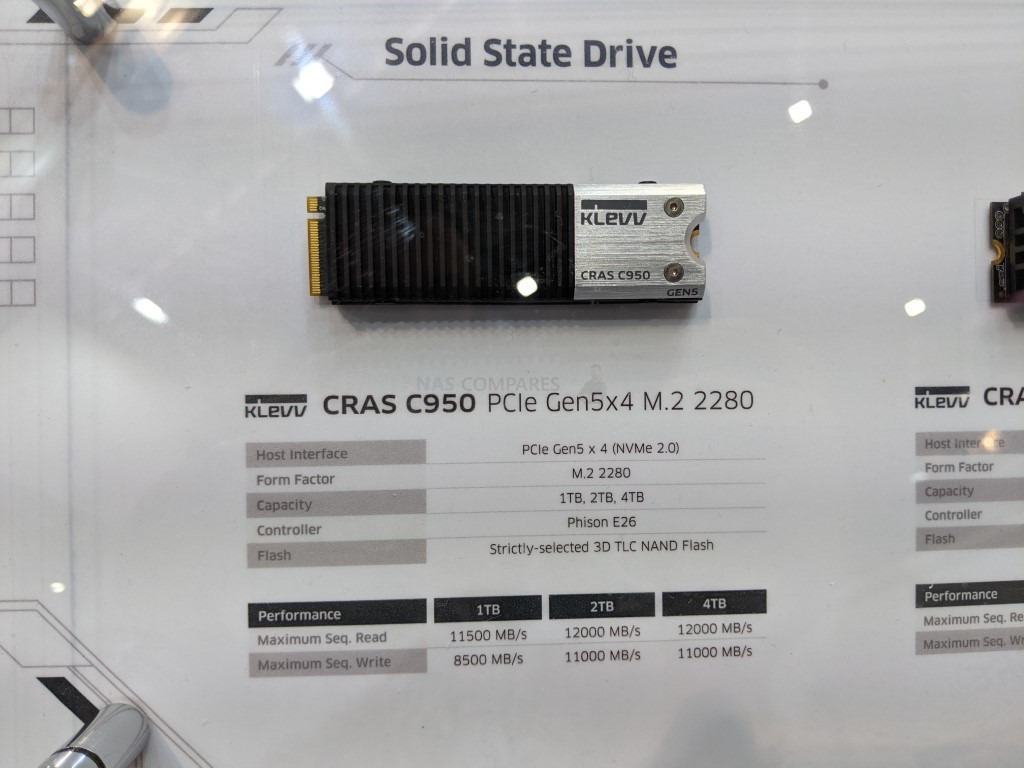
It might not seem the most exciting drive, when the specifications are similar to many that have already been made public in the last 6-7 months, BUT its the fact that we have started seeing more accessible Gen5 SSDs enter the market, which inevitably means this new faster tier of NVMe SSD storage is going to gradually become more consumer affordable!
|
Brand |
KLEVV |
|
Model ID |
CRAS C950 |
|
PCIe Gen |
PCIe Gen 5 x 4 |
|
Capacities |
1TB – 2TB – 4TB |
|
NAND |
3D TLC NAND |
|
Controller |
Phison E26 |
|
Memory |
DDR4 |
|
Reported Max Transfer (Seq R/W) |
12GB/s / 11GB/s |
|
Reported Max IOPS (4K Random R/W) |
TBC |
|
Durability |
TBC |
|
Includes Heatsink? |
Yes, standard style, name plate |
|
Notes |
Taiwanese Local Brand |
Other Gen 5 SSDs to Watch out for in 2023/2024?
In the world of PCIe Gen 5 SSDs, we have already seen a lot of other drives arrive on the scene. Their increased speed and efficiency make them an excellent choice for those who require high-performance storage solutions. Aside from all the Computex 2023 SSDs revealed above, here are the rest of the Gen5 SSDs you should be looking out for as they roll out:
Apacer’s AS2280F5 is another model in the PCIe Gen 5 lineup. While specific capacity and controller information are not available, the AS2280F5 offers read speeds of up to 13.0 GB/s and write speeds up to 12.0 GB/s. The SSD comes with a 5-year warranty.
CFD’s PG5NFZ SSD ranges from 1 to 4TB in capacity and utilizes a Phison PS5026-E26 controller. The model uses Micron 232L TLC NAND and DDR4 DRAM, boasting read and write speeds of 9.5 GB/s and 8.5 GB/s respectively. It also comes with a 3-year warranty.
The Corsair MP700 comes in capacities from 1 to 4TB. With the Phison PS5026-E26 controller, Corsair 3D TLC NAND, and read and write speeds of 10.0 GB/s and 9.5 GB/s, respectively, this SSD offers robust performance.
The Crucial T700 utilizes a Phison PS5026-E26 controller and Micron 232L TLC NAND. With capacities ranging from 1 to 4TB, this SSD delivers read speeds up to 12.4 GB/s and write speeds up to 11.8 GB/s. Crucial also offers a 5-year warranty on the T700.
The Galax HOF Extreme 50 and HOF 50 both offer 1TB and 2TB capacities and utilize a Phison PS5026-E26 controller and Micron 232L TLC NAND. These SSDs offer read speeds of up to 9.5 GB/s and 10.0 GB/s respectively, and write speeds of 8.5 GB/s and 9.5 GB/s respectively. They come with a 5-year warranty.
The Gigabyte Aorus G5 10000 is available in capacities ranging from 1 to 4TB. Utilizing a Phison PS5026-E26 controller and Micron 232L TLC NAND, it offers impressive read speeds up to 10.0 GB/s and write speeds up to 9.5 GB/s. This SSD also includes a 5-year warranty.
Goodram’s IRDM Ultimate SSD comes in capacities from 1 to 4TB. It uses a Phison PS5026-E26 controller, Micron 232L TLC NAND, and can deliver read and write speeds up to 10.0 GB/s and 9.5 GB/s respectively. The IRDM Ultimate also includes a 3-year warranty.
The Inland TD510 is available in 1TB and 2TB capacities. It features a Silicon Motion SM2508 controller, Kioxia 144L TLC NAND, and offers read and write speeds up to 13.0 GB/s and 12.0 GB/s, respectively.
MSI has two options in the PCIe Gen5 lineup: the Spatium M570 HS and M570. Both models use a Phison PS5026-E26 controller and Micron 232L TLC NAND. The Spatium M570 HS is available in capacities from 1 to 4TB and offers read speeds up to 10.0 GB/s and write speeds up to 9.5 GB/s. The Spatium M570 comes in capacities from 1 to 2TB and provides read and write speeds up to 9.5 GB/s and 9.0 GB/s, respectively. Both models come with a 5-year warranty.
The Mushkin Epsilon comes with capacities ranging from 1 to 4TB. Utilizing a Silicon Motion SM2508 controller and Micron 232L TLC NAND, the Epsilon boasts read and write speeds of up to 14.0 GB/s and 12.0 GB/s, respectively.
The Nextstorage Gen5 SSD comes in capacities of 1TB and 2TB. This model uses a Phison PS5026-E26 controller, Micron 232L TLC NAND, and provides read and write speeds up to 10.0 GB/s and 9.5 GB/s, respectively.
The Sabrent Rocket X5 comes in capacities from 1 to 8TB. It uses a Silicon Motion SM2508 controller, Kioxia 144L TLC NAND, and boasts impressive read and write speeds of up to 14.0 GB/s and 12.0 GB/s, respectively.
The SSTC Tiger Shark SSD offers capacities ranging from 1 to 4TB. It utilizes a Silicon Motion SM2508 controller, Kioxia 144L TLC NAND, and delivers read and write speeds up to 14.0 GB/s and 12.0 GB/s, respectively.
Zadak’s TWSG5 SSD is available in capacities ranging from 1 to 4TB. It uses a Phison PS5026-E26 controller with Micron 232L TLC NAND, and delivers impressive read and write speeds up to 10.0 GB/s and 9.5 GB/s, respectively. The TWSG5 comes with a 5-year warranty, ensuring long-term reliability.
Please note that all specifications are as per the information provided by the manufacturers and real-world performance may vary based on system compatibility, usage, and other factors. Always check reviews and user experiences before making a final decision.
And there you have it. Did I miss a drive that was at Computex? Are any of these SSDs shaping up to be ‘the one’ for you and your storage in 2023/2024? Let me know in the comments. Have a fantatsic week!
📧 SUBSCRIBE TO OUR NEWSLETTER 🔔
🔒 Join Inner Circle
Get an alert every time something gets added to this specific article!
This description contains links to Amazon. These links will take you to some of the products mentioned in today's content. As an Amazon Associate, I earn from qualifying purchases. Visit the NASCompares Deal Finder to find the best place to buy this device in your region, based on Service, Support and Reputation - Just Search for your NAS Drive in the Box Below
Need Advice on Data Storage from an Expert?
Finally, for free advice about your setup, just leave a message in the comments below here at NASCompares.com and we will get back to you. Need Help?
Where possible (and where appropriate) please provide as much information about your requirements, as then I can arrange the best answer and solution to your needs. Do not worry about your e-mail address being required, it will NOT be used in a mailing list and will NOT be used in any way other than to respond to your enquiry.
Need Help?
Where possible (and where appropriate) please provide as much information about your requirements, as then I can arrange the best answer and solution to your needs. Do not worry about your e-mail address being required, it will NOT be used in a mailing list and will NOT be used in any way other than to respond to your enquiry.

|
 |
A Buyer's Guide to Travel Routers - GET IT RIGHT, FIRST TIME
Jonsbo N6 DIY NAS Case Review
The Best Bits (and Worst Bits) of NAS of 2025!
Minisforum MS-02 Ultra Review
Minisforum N5 NAS, 6 Months Later - Better, Worse, the Same?
Beelink ME Pro NAS Revealed
Access content via Patreon or KO-FI
Discover more from NAS Compares
Subscribe to get the latest posts sent to your email.


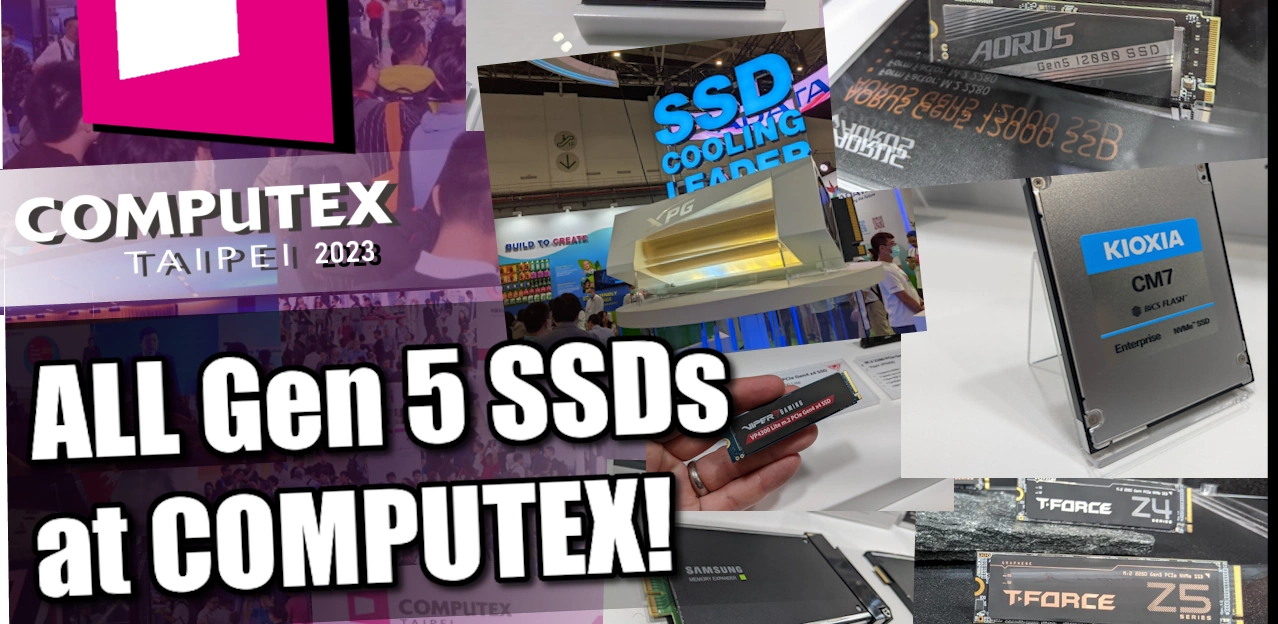



Excellent review…….I am buying it ONLY FOR 1000 TBW…..and thats it….gonna use it on Gen3 pcie slot……
REPLY ON YOUTUBE
Is the Patriot Viper VP4300 still working well after 3 years?
REPLY ON YOUTUBE
M80 will not fit to hold down T700 Crucial M.2 5.0 in the first slot? What size is the screw that holds it down?
REPLY ON YOUTUBE
Wait for the QNAP TBS-574TX
REPLY ON YOUTUBE
An excellent review in a space of great interest to me. Well done. Regards mark
REPLY ON YOUTUBE
Thanks
REPLY ON YOUTUBE
Thank you VERY much for delivering all those information!
REPLY ON YOUTUBE
So when will I be able to upgrade from my 2TB samsung 990 pro and my 2TB WD SSD Black SN850? The sequential read speeds do have /some/ value for me for game loading. But I don’t game much today. And so far the only statistic I care about (random read/write) is slower on all Gen5 SSDs than on my Gen4 SSDs
REPLY ON YOUTUBE
Nice review.
REPLY ON YOUTUBE
Are there any computers currently available that can support gen 5 SSDs?
REPLY ON YOUTUBE
Ideal and most comprehensive review i’ve ever seen. An example how all reviews have to be done
REPLY ON YOUTUBE
Thks Robbie & hi Eddie;
Robbie won’t let me say hi to the Sea-Gull (eddie, say hi for me anyways though 😉
REPLY ON YOUTUBE
I’ve been watching the videos out of Taiwan (ideally before the PLA comes to visit) that mention “Thunderbolt”. As a Mac user I’m used to Thunderbolt way back (as a FireWire replacement). Is this current “Thunderbolt” the same technology (i.e. I can use it on a Mac) or is this just the term recycled and applied to different technology (the ports look very similar to USB C)?
REPLY ON YOUTUBE
Having seen the show floor photos for the cooling needed by these Gen5 M.2’s, I see little hope someone’s NAS enclosure will support beyond perhaps teaming with ONE specific physical form.
REPLY ON YOUTUBE
APPRECIATE Eddie has a better mic.
REPLY ON YOUTUBE
Great video, loved the idea of someone impersonating an audience and all the questions were on point
REPLY ON YOUTUBE
Thanks!
REPLY ON YOUTUBE
I would like to see more AI progression on their Photo’s. Right now it is quite querky. Showing the same person in the same outfit and nearly identical photos as two different people or people that are quite different as the same with out an easy way on the mobile app to seperate them from each other.
REPLY ON YOUTUBE
16:15 Couldn’t Synology at least remove the protective plastic film off the front of one of their most expensive desktop models when it’s on display for the world to see ? This was a really great wrap-up Robbie and Eddie; thank you very much.
REPLY ON YOUTUBE
I wish Synology would release something like the QNAP TBS-574TX.
REPLY ON YOUTUBE
Nice stickers Realtek, on the routers.
REPLY ON YOUTUBE
Lmao imagine adata follows the gen 5 trend of 2gb per tb. That would mean 16gb of ram on their 8tb ssd lmao. Hell honestly id take 8gb seeing theres no consumer 8tb nvme ssd with even more than 2gb as far as im aware.
REPLY ON YOUTUBE
Must have rocks such in mouth. Keeps saying coaxia not kioxia (key-oxe-see-ah) ????️????????️????️
REPLY ON YOUTUBE
I’d be interested in a video that goes though the pros and cons of these three NAS operating systems head to head for converting an old computer to a NAS – XPEnology / Truenas / Unraid
REPLY ON YOUTUBE
Safe trip home.
REPLY ON YOUTUBE
Adata’s “water cooling” is just a gimmick. There was some ram that had something similar, I don’t recall who made it but I do remember it did nothing. Having a heat pipe and fins would be way better for heat dissipation in a package that big.
REPLY ON YOUTUBE
I don’t think the consumers need a big ssd m2 package with a big heatsintk. I would prefer a slower but slim m2 ssd for my laptop, PC or home server.
REPLY ON YOUTUBE
This comes at the right moment as we are preparing to replace our older NetApp storage that I have been managing for almost 4 years now. I envision to see an enormous amount of power savings on the whole expensive fiber channel infrastructure moving into ISCSI and NFS and into less rack space. This will become a truly hybrid setup where we can switch between on premise and cloud in real time and not in some dreamed up “architect’s” mind six years ago.
REPLY ON YOUTUBE
Did you visit Solidigm and if so what do you think of there software update?
REPLY ON YOUTUBE
NICE
REPLY ON YOUTUBE
And no seagulls at least yet.???? I’m actually missing you say that…. Lmao….
REPLY ON YOUTUBE
If I already have built-in heatsink with my Motherboard, do I still need/can use the heatsinks included with this SSD?
REPLY ON YOUTUBE
Lol you just voided your warranty by removing that sticker bro! That sticker said that the 5 year “warranty is void if removed.”
REPLY ON YOUTUBE
Is this one better then the Addlink?
REPLY ON YOUTUBE
Try it with Slovenian heatsink 🙂
REPLY ON YOUTUBE
I’m here for the tech and the Monty Python reference????
REPLY ON YOUTUBE
I have this. The PS5 displayed a rating of 6025MB/s for the 2TB.
REPLY ON YOUTUBE
????
REPLY ON YOUTUBE
????????????????????
REPLY ON YOUTUBE